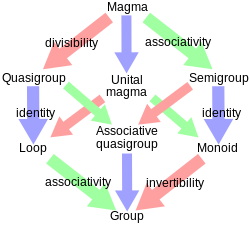Magma (mathematics)
In mathematics, a magma is kind of algebraic structure. It is a set with a binary operation on that set.
A binary operation works by taking two elements from a set (that do not have to be different) and returning some other element of that set.
If we give the set a label (such as X) and the binary operation a label (such as •). Then we give the magma the label (X, •).
Examples
The natural numbers with addition form a magma. Because the set of natural numbers is written as [math]\displaystyle{ \mathbb{N} }[/math] and addition is written as [math]\displaystyle{ + }[/math] the magma is written as [math]\displaystyle{ (\mathbb{N} , +) }[/math]. The name of the magma would be "The natural numbers under addition".
The integers with multiplication form a magma. Because the set of integers is written as [math]\displaystyle{ \mathbb{Z} }[/math] and multiplication (in abstract mathematics) is written as [math]\displaystyle{ \cdot }[/math] the magma is written as [math]\displaystyle{ (\mathbb{Z}, \cdot) }[/math]. The name of the magma would be "The integers under multiplication".
The real numbers under division do not form a magma. This is because numbers cannot be divided by 0. A binary operation requires that any two elements can be taken from the set (in this case in order) to produce another element from the set. The real numbers without 0 is written as [math]\displaystyle{ \mathbb{R}^* }[/math]. It can be shown that the [math]\displaystyle{ (\mathbb{R}^*, \div) }[/math] is a magma.
